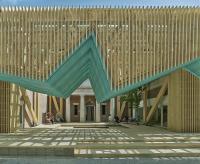Water Temples
The Water Temple celebrates the hydrological process through the deification of water and religious architecture. It proposes a renaturalization strategy that increases urban permeability by using natural micro-catchments, thus mitigating urban flooding. These micro-catchments are presented in architectural forms of temples that are able to clearly display their function within the environment. The temple is a hydrophilic structure that collects filters, and stores rainwater. The water passes through a series of mushroom-like containers that filter water by holding natural coarse and fine aggregates. This transparency and display of the hydrological process informs the community and allows them to participate in the process of hydrological restoration.
The depletion of groundwater is the other side of flooding that is largely unknown or ignored. The water temple not only stores water, it also redirects excess water into groundwater reserves. The replenishment of groundwater secures water equity.
Various typologies are designed to mitigate flooding in the various landscapes and social structures of Lagos. Temples with multiple catchment layers are able to collect and filter more water for neighborhoods that require larger amounts of water resources. Temples that create larger meeting spaces on the ground level can be placed in neighborhoods that have been built without room for societal conjunction. Within the immediate floodplain, temples that support organic agriculture can be utilized as a meeting point of water and act as a coordinator of water flow into the river and its tributaries. These are designed in circular formations in order to give importance to the role of the vegetation it surrounds. This creates an icon, a symbolism that informs its users about the importance of vegetation as a functioning and necessary part of flood mitigation.
The strategy of water deification and utilization of religious architecture is pertinent to giving cultural semblance to the global urgency of disseminating environmental intelligence. The Water Temple is an architectural reconstruction of colonially subverted environmental consciousness.




















